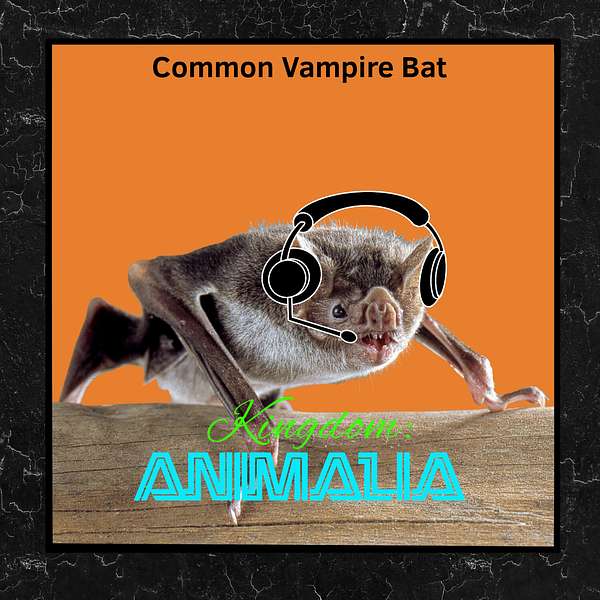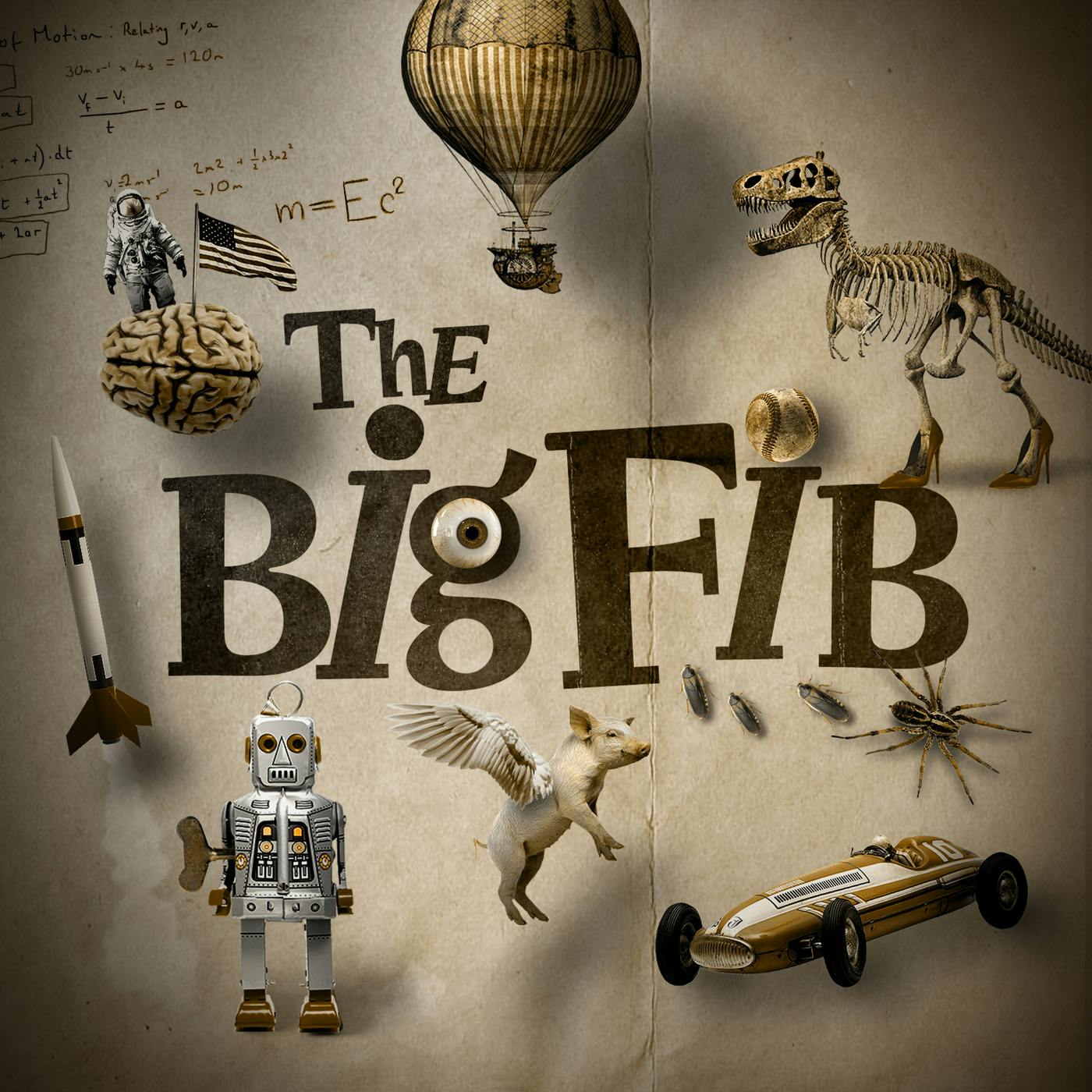
Kingdom: Animalia - A Zoology Podcast for Kids
This is a for-kids-(and adults)-by-kids-(and chickadees) animal podcast. In every regular episode, your host, Devon, and podcast-overthrowal-plotting chickadee co-hosts, Chet and Cap, will dive into all the facts about one species of animal with jokes, fun facts, and quizzes along the way. Every third-ish episode is our game show, Animalia Fake!, in which there are three rounds with four outrageous animal facts; one of those facts is so outrageous it’s an Animalia Fake (it’s not true), and you have to guess which it is.
You can send in questions and episode suggestions to animals@kapods.org, and my website is https://kapods.org/animals. So what are you waiting for? Let’s explore this amazing Kingdom: Animalia.
New episodes every 1–2 months.
Kingdom: Animalia - A Zoology Podcast for Kids
Common Vampire Bat
Their bad rap is completely batty!
______________________
Do Vampire Bats drink human blood (**SPOILER ALERT: NO**)? Do bats deserve their bad reputation? Have people gone to war over bat poop? Did scientists have Common Vampire Bats go to the gym? Are Vampire Bats actually very nice to each other? Today with your host, Devon, and co-hosts, Chet and Cap, on Kingdom: Animalia’s 1st ANNIVERSARY episode, you will learn everything there is to know about the Common Vampire Bat, Desmodus rotundus.
Further Reading (Experiments):
- Vampire Bats Call Out to Friends to Share Blood Meals
- Unlike other bats, vampire bats keep out of trouble by running, Cornell researchers find
Other Links:
Credits:
- Episode Art: Uwe Schmidt, CC BY-SA 4.0, via Wikimedia Commons; background removed.
- Additional Music: Blue Dot Sessions and Kevin MacLeod
If you have any questions, comments, episode suggestions, or verification that I’m not just talking into the void, please send them in (links below)! It really means a lot. Also, if you like this podcast, please share it with someone else who might!
Get in Touch: animals@kapods.org or kapods.org/contact
Visit My Website: kapods.org/animals
Follow in Your Favorite App: kapods.org/animals/follow
**Psst! Hey, you! It’s Chet and Cap! Do you have any questions for us? Just head over to kapods.org/acb and send a voice message or email with your questions, and we’ll answer them on an Ask the Chickadee Brothers episode of this podcast!**
Until next time, keep exploring this amazing Kingdom: Animalia.
This podcast is made by Kingdom: Animalia Podcasts.
SOUNDS: [Halloween Intro Music]
BACKGROUND: [Halloween Intro/Outro Underscore starts]
DEVON: Hello and welcome to-- Wait… let’s try that again.
SOUNDS: [Click]
DEVON: <Creepy voice (Deep, reverberating voice effect)><Hello and welcome to Kingdom: Animalia - A Zoology Podcast for Kids. Mwah, hah, hah, haw!>.
CAP: Chicka If you Chicka think that’s Chicka going to Chicka scare me, Chicka you’d be Chicka wrong, Devon.
DEVON: Well, I guess I can’t scare you, Cap.
CAP: Chicka You betcha.
DEVON: Boo.
CAP: Chicka Woah! Chicka My godwit!
DEVON: He-heh.
CAP: Chicka Not funny.
DEVON: If you say so, Mister Brave. Okay. So, today is not only Kingdom: Animalia’s 2023 <creepy voice><Halloween episode>… It’s also its first birthday!n’s Chicka definition of Chicka cute is Chicka debatable, as Chicka he also Chicka finds cockroaches Chicka cute.
DEVON: Now you’re just dissing cockroaches. Their bad rap is a completely different episode. Anywho, let’s move on. I’m your host, Devon,…
CAP: …Chicka We’re your Chicka co-hosts, Chicka Cap…
CHET: …Chicka And Chet!…
DEVON: And today on Kingdom: Animalia’s <creepy voice><Halloween 2023> slash first anniversary episode, we’re talking about the Common Vampire Bat, Desmodus rotundus;one of the only three—only THREE—species of bat that drinks blood. Enjoy <creepy voice><and beware! Mwah, hah, hah, haw!>
SOUNDS: [Snap]
BACKGROUND: [Music ends]
SOUNDS: [Animal Misconceptions: Debunked chime]
DEVON: Before we get into the episode, I have to clear some things up. It’s time again for Animal Misconceptions: <echo><Debunked>.
BACKGROUND: [Halloween Music 2 starts]
DEVON: First misconception: bats are blind, as in the saying “Blind as a bat.” Bats are not at all blind. People likely think they are because they use echolocation (if you didn’t know, echolocation is animal sonar, in which the animal emits high-pitched sounds which bounce off of objects and then go back to their ears, giving them a picture of their surroundings). But they really can see and some species actually depend on it! In fact, one of the two main groups of bats, Flying Foxes AKA Fruit Bats, don’t have echolocation and simply use vision. This is because one of their main food sources is fruit, which requires them to use sight to know if they’re ripe, as echolocation only communicates shape and texture. Secondly, not all bats drink blood. There are only three species of blood-eating bats (which are also the only mammals that eat only blood): The Common Vampire Bat (today’s animal), Hairy-legged Vampire Bat, and White-winged Vampire Bat. Lastly, Vampire Bats do NOT eat human blood! Depending on the species, they’ll eat from livestock, birds, or other animals. That is all. This has been Animal Misconceptions: <echo><Debunked>.
BACKGROUND: [Music music begins to fade out]
SOUNDS: [Animal Misconceptions: Debunked chime]
DEVON: Alrighty then, let’s begin with the description, as usual. For this you need to channel your mind’s eye.
CHET: Chicka Okay…?
BACKGROUND: [Alien Invasion starts]
DEVON: First imagine a basic bat—yes, there are many species and variations, but imagine the general bat, like a Brown Bat or Mexican Free-tailed Bat. If you don’t know what this kind of bat looks like, here’s a quick description: First imagine a grayish-brown mouse. Then shorten their snout; flatten their nose; and give them larger ears. Then shorten their forelegs so that they’re just paws. Then stretch out their front toes to be longer than their body; long, skinny, and boney. Leave out their thumb, keeping it small and movable—bats use their thumbs for all sorts of things, like climbing and perching. Then put webbing, a thin, stretchy skin, between each of their long front toes—yes, bat wings are indeed their forepaws. Then connect the webbing down from the bottom-most toe of each wing to their hind legs and their hind legs to their furred, medium-length tail. So that’s what the building block bat we’re using looks like. Now for the Common Vampire Bat customizations.
SOUNDS: [Quick Metal Riff]
CAP: Chicka Oh, yeah!
DEVON: First, get rid of the tail. Common Vampire Bats—I just learned this as well—have no tail. As a minor but related detail, the webbing between their hind legs, called the uropatagium, is smaller than in other bats. Next, scrap the snout—just get rid of it. Now, replace it with a pig snout.
CHET: Chicka Wait, what?!?
DEVON: Yes, a pig snout. But scaled down, of course.
CHET: Chicka Of course.
DEVON: Then, squash it down into the face. Not wrinkled like a pug, just shorter.
CHET: Chicka Let me Chicka get this Chicka straight, their Chicka snout looks Chicka like a Chicka short pig Chicka snout?
DEVON: Yes.
CHET: Chicka Okay.
DEVON: Don’t worry, Chet, this episode will get WAY weirder.
CHET: Chicka Thanks for Chicka the word Chicka of warning.
DEVON: Now for the final touch: the teeth. They may have a pig-like snout, but their teeth are far from a pig’s. Because Common Vampire Bats’ diet is solely blood—a liquid—they don’t have many teeth—as adults they’ll have almost twenty—but they’re razor-sharp. You know what a snake’s fangs look like—not those of vipers, but of other snakes? Long, narrow, and pointed? Well add those to the Vampire Bat in your head. When you look at a Common Vampire Bat from the front, you’ll only see around four of the teeth: the incisors—those are the main front teeth used for cutting—in Vampire Bats, they’re shorter and they have four—two on top, two on the bottom—and their canines—those are the four large teeth that surround the incisors (one on either side of the incisors) and are often the largest teeth in mammals—and Vampire Bat canines follow the same rules. Congratulations, you’ve created your very own mental Common Vampire Bat!
SOUNDS: [Ta-da!]
CAP: Chicka That was… Chicka an experience.
BACKGROUND: [Music fades out]
DEVON: Now let’s get into the specifics.
BACKGROUND: [Halloween Music 1 starts (speech starts after first “verse” of music)]
DEVON: Since we’re already on the topic of teeth, let’s finish that off. Common Vampire Bat teeth, over time, have evolved significant differences from those of other bats: Relative to other bats, their front fangs are extremely sharp. Their upper incisors specifically are especially sharp relative to those of other bats’ because…
CAP: Chicka I feel Chicka a multiple Chicka choice question Chicka coming on.
DEVON: You felt correctly. Their upper incisors are especially sharp because… A), They sharpen them on tree branches; B), They don’t have a substance called enamel protecting them; or C), The blood they drink reinforces them, allowing them to be narrower without breaking. What do you think? Cap?
BACKGROUND: [Music stops abruptly] [Cap Overlord music [Meditation music starts] [Creepy Choir starts (over music)]]
CAP: Chicka Ommmmm. Chicka Cap Overlords, Chicka oh great Chicka Cap Overlords.
DEVON: Cap, what are you doing? Chet, what is Cap doing?
CHET: Chicka Search me.
CAP: Chicka Using my Chicka sorcery, I Chicka call upon Chicka you, oh Chicka great Cap Chicka Overlords. Chicka I seek Chicka answers: What Chicka is the Chicka answer to Chicka Devon’s multiple Chicka choice question, Chicka great overlords?
DEVON: Cap, I don’t think you’re g--
CAP: Chicka Shh! Chicka The great Chicka Cap Overlords Chicka are trying Chicka to speak! Chicka Ommmmm. Chicka The great Chicka Cap Overlords Chicka have spoken! Chicka The answer Chicka is…
SOUNDS: [Magic Spell Sequence]
CAP: Chicka C!
BACKGROUND: [Music ends quickly with quick lowering of pitch]
DEVON: O… kay… then… Chet! What do you think?
CHET: Chicka With all Chicka of my Chicka brother’s… uh… Chicka “thing”, I Chicka kind of Chicka forgot my Chicka answer, so Chicka I’ll just Chicka go with Chicka C.
DEVON: Okay then. Chet, can I get a drumroll please?
CHET: Chicka Yes. Chicka I don’t Chicka need hat Chicka gods…
CAP: …Chicka Cap Overlords…
CHET: …Chicka to know Chicka the answer.
BACKGROUND: [Drumroll]
DEVON: The answer is… B!
SOUNDS: [Incorrect]
CHET: Chicka It sounds Chicka like your “Chicka great Cap Chicka Overlords” were Chicka wrong, Cap.
CAP: Chicka They probably Chicka didn’t want Chicka to tell Chicka me the Chicka correct answer Chicka because you Chicka were going Chicka to steal Chicka my answer.
CHET: Chicka That’s totally Chicka why.
DEVON: Anywho, so Vampire Bats’ fangs are so sharp because they don’t have enamel. Enamel serves as the protective layer of most mammals’ teeth. In mammals that have it, it is the hardest material in their body. The lack of this enamel makes their upper incisors razor-sharp. Another difference between theirs and other bats’ is that their back teeth are shorter and duller than the rest of their teeth, as they don’t use their hind teeth for piercing like their front teeth or chewing like the hind teeth of other bats. They use these unique front teeth to make small cuts in their prey. More on that later. In fact, their fangs are so important that their braincase in their skull is smaller to make room for their large incisors and canines! Now for their general description.
BACKGROUND: [Halloween Music 5 starts]
DEVON: The Common Vampire Bat has grayish-brown fur overall which is lighter on their underside. Their snout is compact, almost swollen looking, and their ears are pointy. They grow two point eight to three point five inches or seven to nine centimeters long (head to tail) and their wingspan is roughly thirteen point eight to fifteen point seven inches or thirty-five to forty centimeters wide. Just like the Orchid Mantises from episode five, Common Vampire Bats are sexually dimorphic. Sexual dimorphism, in case you forgot or haven’t listened to episode five, is where one sex of an animal is larger or prettier than the other. In the case of the Vampire Bat, it means that the females are larger. Common Vampire Bats weigh around point five to one point eight ounces or fifteen to fifty grams. That’s roughly the same weight as… A), A golf ball, B), A dodgeball, or C), A soccer ball?
CHET: Chicka A!
BACKGROUND: [Music ducks][Cap Overlords music starts]
CAP: Chicka The great Chicka Cap Overlords Chicka say the Chicka answer is…
SOUNDS: [Magic Spell Sequence]
CAP: Chicka A!
BACKGROUND: [Cap Overlord music ends quickly with quick lowering of pitch][Halloween Music 5 goes back to full volume]
DEVON: Chet, can you give me a drumroll please?
CHET: Chicka You betcha!
DEVON: But wait until after a quick break.
CHET: Chicka Now that’s Chicka just cruel.
BACKGROUND: [Music fades out]
…
BACKGROUND: [Halloween Music 4 starts]
DEVON: Welcome back to Kingdom: Animalia - A Zoology Podcast for Kids. I’m your host, Devon,…
CHET: ….Chicka We’re your Chicka co-hosts, Chet…
CAP: …Chicka And Cap,…
DEVON: …And today we’re talking about the Common Vampire Bat, Desmodus rotundus. Before the break, we…
CHET: …Chicka you…
DEVON: …Okay, I left you with a dangling question: The Common Vampire Bat weighs roughly as much as A), A golf ball, B), A dodgeball, or C), A soccer ball?
CHET: Chicka I guessed Chicka A…
CAP: …Chicka And the Chicka Cap Overlords Chicka also told Chicka me that Chicka it’s A.
DEVON: Now you can give me that drumroll, Chet. The answer is…
SOUNDS: [Drumroll]
DEVON: A! You’re both right!
SOUNDS: [Correct]
CAP: Chicka I told Chicka you to Chicka never doubt Chicka the great Chicka Cap Overlords.
CHET: Chicka Uh-huh.
BACKGROUND: [Music ends like original ending]
DEVON: The Common Vampire Bat is highly adapted to their feeding habits, we talked about their teeth earlier, but here are some more of their adaptations:
BACKGROUND: [Halloween Music 2 starts]
DEVON: One is that they have a special tongue. They have two grooves on its sides that expand and contract as the bat drinks blood. Common Vampire Bats have a strong sense of smell for finding prey and large eyes. The thumb of their wing is long and well-developed and has three pads that serve as a sole. They use these thumbs for climbing on their prey, locomotion, and takeoff. They also have strong hind legs. As you probably should know by now—if you don’t, you really should pay more attention—Common Vampire Bats eat blood and only blood. Vampire Bats, as said earlier, are both the only bats who feed on blood and the only mammals that feed entirely on blood. In current times, Common Vampire Bats prefer to drink the blood of livestock, like cows, horses, and pigs, and large wild mammals, like tapirs (tapirs are like combinations between deer and elephant seals. You should look up a photo). In captivity, on the other wing, they have been recorded eating blood from lizards, snakes, crocs, turtles, and--
CHET: Chicka Birdseed!
DEVON: It was starting to feel like you two wouldn’t be interrupting this episode. In captivity, they have been recorded eating the blood from lizards, snakes, crocs, turtles, and toads. There we go.
BACKGROUND: [Music fades out]
DEVON: We’ve talked about the fact that Common Vampire Bats drink blood a lot this episode.
CHET: Chicka You’ve mentioned Chicka it once Chicka or twice.
DEVON: But what we haven’t talked about is how they do it. Well now I’m going to teach you a crash course on How Vampire <echo><Bats> <Drink> <Blood.>
SOUNDS: [Bat Wingbeats]
BACKGROUND: [Crash Course Music starts]
CAP: Chicka Step number Chicka one:
DEVON: Finding a Blood Source. Common Vampire Bats will first use echolocation and vision to navigate and find their prey. They might also use scents and sounds to locate their next meal.
CAP: Chicka Step number Chicka two:
DEVON: Touch Down. Common Vampire Bats are stealthy and agile. The bats don’t land directly on their prey, so as not to wake them, but instead land nearby and walk or hop—yes, they can walk and even hop!—over to their slumbering prey. They then climb up onto the large mammal to find a suitable feeding spot. For reasons unclear from my sources, Common Vampire Bats usually climb up their prey sideways or backwards! They are very alert when climbing and also light on their feet—because if they were to wake their prey, well let’s just say it wouldn’t go too well for the bat.
CAP: Chicka Step number Chicka three:
DEVON: Making a Tap. Desmodus rotundus is equipped with a heat sensor at the end of their nose to point them towards where warm blood flows closest to their prey’s skin! Just if you thought Common Vampire Bats didn’t have more up their winged sleeves. Before making a cut, the bat shaves off a patch of fur around the “surgical site”, much like a vet prepping for a surgery on a mammal, though the bat uses their rough tongue instead of a razor. Next, the bat uses those sharp incisors and canines we talked about earlier to make an almost exactly point one inch or three millimeter incision into the prey’s skin. The bite is pretty much painless and rarely wakes up the animal. Researchers have found a special anticoagulant in Vampire Bat saliva. An anticoagulant is a substance that prevents blood from clotting, in other words: stopping bleeding. This keeps the blood flowing for the Vampire Bat to drink. Can you guess what it’s called? Any guesses? The answer is…
SOUNDS: [Drumroll]
DEVON: Draculin. Yes, that is in reference to the world’s most famous vampire: Count Dracula.
CAP: Chicka Step number Chicka four:
DEVON: Bon Apétit. The Common Vampire Bat then drinks their fill, which is usually only around a tablespoon. They don’t actually suck the blood like fictional vampires, they instead lap up the blood with their tongue, like a dog or cat drinks water.
CAP: Chicka Step number Chicka five:
DEVON: The Exit. Common Vampire Bats then take off from the ground. After having a large meal, they have to use a little more push to get off of the ground. They are the only species of bat—even excluding other Vampire Bats, both other species feed mainly on birds that roost in trees, allowing them to simply drop down—to be able to lift off directly from the ground.
CAP: Chicka Sidenote:
DEVON: Common Vampire Bats use agile moves and quick reflexes to avoid unpredictable responses from large prey. Jumping is their main way to get out of the way of danger. They can jump forward, backward, and straight up to make a quick escape in the case of an emergency such as kicking hooves; whipping tails; and their predators, which we’ll discuss later.
BACKGROUND: [Music ends]
DEVON: This concludes our crash course on How Vampire <echo><Bats> <Drink> <Blood.>
SOUNDS: [Bat Wingbeats]
DEVON: As we just talked about, moving on the ground is an important part of Common Vampire Bats finding stalking and feed off of prey. Unlike other bats, Common Vampire Bats can walk, hop and even run on their wings and hind legs, hence the--
CAP: Chicka Caps!
DEVON: Ugh. No. Hence their powerful, soled thumbs and strong hind legs. When they need speed, They tend to run or hop. The lifespan of a Vampire Bat can be up to twelve years. Being social is such a big part of Common Vampire Bats’ lives that we need to devote a whole segment to it. It’s time for social behavior.
BACKGROUND: [Compton starts]
DEVON: Desmodus rotundus lives in colonies that can range from… A), Tens to dozens; B), Tens to hundreds; or C), Tens to thousands?
CHET: Chicka Here we Chicka go again.
BACKGROUND: [Music ducks][Cap Overlords music]
CAP: Chicka The great Chicka Cap Overlords Chicka say the Chicka answer is…
SOUNDS: [Magic Spell Sequence]
CAP: Chicka B!
BACKGROUND: [Cap Overlord music ends quickly with quick lowering of pitch][Compton goes back to full volume]
CHET: Chicka And I’ll Chicka go with Chicka C.
DEVON: Chet, you know what to do!
BACKGROUND: [Drumroll]
DEVON: The answer is… C! Chet, you’re right,…
SOUNDS: [Correct]
DEVON: …but Cap, the great Cap Overlords have failed you.
SOUNDS: [Incorrect]
CAP: Chicka Rrr! Chicka Cap Overlords! Chicka How?!?
DEVON: Anywho… S--
CAP: Chicka How could Chicka you fail Chicka me, oh Chicka great Cap Chicka Overlords?!?
DEVON: Speaking loudly: ANYWHO… Normal volume: These colonies usually have around twenty to one hundred bats, though the largest ones recorded have been up to five hundred bats strong! These colonies congregate in roosts—much like the crows and turkeys from episodes one and two—in tree hollows, caves with at least some light and deep fissures (cracks), mine shafts, old wells, and abandoned buildings. These roosts will smell strongly of ammonia because of the digested blood in their guano (guano is what you call bat (and seabird) feces). These colonies consist of a mix of both males and females. When in captivity, dominance hierarchies (who has more say and control than another, like alphas, betas, etc.) based on who gets food have been observed, but there is very little conclusive (strong) evidence to say that that is the case in the wild. Close friendships are formed between multiple female Common Vampire Bats or females and their pups (that’s what you call a baby bat). Adult males don’t form these ties and tend to be loners. Females travel between different colonies more than males, making quote on quote “bat friends” in many different places. These friendships can last for many years. A scientist named Gerald Wilkinson reported that though the bats will sometimes groom themselves, social grooming between bats is an important part of their behavior in the roost. Social grooming is usually between mothers and pups, though it also happens frequently between adult females, these females usually being close family members or friends. Wilkinson found that social grooming actually has more to do with sharing food than removing parasites from each other. Most of the time, social grooming starts with one female coming up to another and grooming her for up to two minutes. Then, the female being groomed will regurgitate part of her blood meal to the other. Common Vampire Bats in general, not just female friends, will share blood: in some cases, when Bat A couldn’t find food but Bat B is nice and full, Bat B will offer food to A. Later, when the roles are reversed, A is expected to return the favor by feeding B. If A doesn’t return the favor, B won’t help them out another time. It’s basically like this: If I feed you when you’re hungry, you feed me when I’m hungry. If you don’t, I won’t feed ever again. Though adult bats don’t usually call to communicate with each other, touch and chemical cues detected through smell are likely important parts of communication.
BACKGROUND: [Music fades out]
DEVON: When it is time for breeding, males will compete for roosting sites in which females reside.
BACKGROUND: [Battle Ready starts]
DEVON: If more than one male is in a roost, each individual defends a small part of it. According to Wilkinson, defense of roosts often includes chasing; pushing; and all out fighting which includes biting, wing-striking, and gesturing. The male defender will mate with each of the females in his territory when she’s ready.
BACKGROUND: [Music fades out]
DEVON: D. rotundus is thought to be able to mate throughout the year.
BACKGROUND: [Harlequin slowly fades in in background]
DEVON: Even though pups can be born at any time of the year, as breeding can take place throughout it, peak birthing times (the times when the most pups are born) were shown to be during April and May and October and November. The gestation period (the period of time between when a female mates and gives birth) is around seven months and females usually only have one pregnancy a year, though it is possible for them to have more. Usually mothers have only one pup, but occasionally they’ll have twins. When they’re born, the pups are well developed (fully-furred and alert) and weigh around point three ounces or seven grams. Vocalizations are common between mother and pup. Quiet contact calls are made by the pup (they’re at around six to twelve kilohertz, if you can think in measurements of sound frequencies, I can’t). These are usually made when the mother is feeding the pup or when the pup is trying to find her. During their first month, the pup will feed only on their mom’s milk, doubling their weight, and cling tightly to her in flight. The mom will introduce them to blood through regurgitation in their second month. The pup will join their mother on hunts when they reach four-months-old. They’re then fully independent by five months!
CHET: Chicka Eh, birds Chicka are much Chicka faster.
DEVON: That’s something I never thought I’d hear someone brag about. So, when they become independent, young Common Vampire Bats don’t show aggression to each other but, like many young mammals, play fight and wrestle with each other. To avoid aggressive encounters with older bats in the colony, juveniles will perform somewhat of a peace offering, in which they bend to one side and lift a folded wing.
BACKGROUND: [Music ends]
DEVON: This episode, we’re bringing back an old segment from episode one: Experiments.
SOUNDS: [Experiments Sting (music fades under speech)]
DEVON: Today we’re bringing you two stories about Common Vampire Bat research. The first one is on feeding and friends.
BACKGROUND: [Experiments music starts]
DEVON: Similar to us humans and other animals, Common Vampire Bats have social preferences, like you might have a best friend, a friend, and some person you just know. Researchers at Ohio State University (OSU) wanted to find out whether these bats forage with friends or just alone. Their study showed that Desmodus rotundus almost always left for dinner alone, but often joined other bats for the meals. Additionally, female Vampire Bats that were friends and spent a lot of time together in their roost, were more likely to share their blood meals, says OSU ecologist Gerald Carter. Well what do you know, another Gerald! I guess there are a lot of Vampire Bat researchers named Gerald. His team recorded the bats making three distinct calls at feeding locations that suggested that friends communicate with each other about the food that’s available. Carter’s team studied two different colonies living near cattle ranchers in rural parts of Panama. In the first location, named Tolé, the research team focused on a fairly large bat colony that had about two hundred twenty-five bats on average. Using nets that they stretched out in front of the bats’ paths, the researchers captured and tagged fifty females with tracking devices which they used to monitor their movement for several days. These trackers showed the researchers where the bats were within the roost and helped them determine which bats were friends. The bats with more friends in the roost also met up with more friends when foraging, the team found. At the second location, called La Chorrera, Carter’s team observed the bats as they flew to a herd of cows and recorded their interactions. Studying the bats at night in La Chorrera required them to befriend the cows. “At first, the cows would move away from me, but after a[ ]while, they got used to me, so I basically became part of the herd,” says Simon Ripperger, a biologist and study author at OSU. To observe the bats, Ripperger carried an infrared camera and ultrasonic microphone that could record the high-pitched bat calls which are too high for humans to hear. He used the infrared camera because using any lights to see the bat test subjects would scare them away. As the bats fed, they very clearly made numerous calls, either to attract or deter other bats. Ripperger noticed that when the bats called, other bats would arrive and they would either lap up the blood together or fight over it. The study focused on female Common Vampire Bats because, as previously mentioned, males are territorial and don’t make friends. The recordings Ripperger collected at this study site point towards three call types: A call that might be to alert or recognize friends, a buzz that the team interpreted as “stay away”, and a third never-recorded-before call that may be to coordinate or compete over food, Carter says. These social feeding communications may give notified bats some advantages: For instance, prepping a wound takes time and work, leaving the bat more vulnerable to predators, such as owls. The longer they sit on the cow’s back, the greater the chances they’ll get eaten. Bats who are invited to other bats’ meals are able to immediately start eating, leaving them exposed for less time. These bats—which get a bad rap from their blood diet—are actually not unlike us: “[This] shows that the way bats behave in some ways is so similar to how we, humans, behave,” Brian Bird at the University of California, Davis, who also studies bats, but wasn’t involved in the research, says. “They preferentially take care of family members and friends.”
BACKGROUND: [Music ends]
DEVON: Now here’s the second study which is on Vampire Bat locomotion.
BACKGROUND: [Chill Beats starts]
DEVON: As we talked about earlier, Common Vampire Bats can behave much like four-legged terrestrial mammals in how they move on the ground, where other bats will fumble and tumble. Researchers of Cornell University’s College of Veterinary Medicine discovered that this species can not only walk… but run! The experiment was done by Daniel Riskin, a Cornell graduate student in zoology, and his adviser John W. Hermanson, an associate professor of biomedical sciences. It was published in the Nature magazine on March 17, 2005. Riskin came up with what seemed like a crazy idea: challenging these Common Vampire Bats on an increasingly fast treadmill!
BACKGROUND: [Music stops]
SOUNDS: [Record Scratch]
CROWD: {Gasps}
CHET: Chicka Say what?
BACKGROUND: [Music restarts]
DEVON: I know, it sounds—is—crazy. If you don’t believe me, I linked a video in the show notes, episode page, and transcript {link}. I STRONGLY encourage you to watch it. “What we observed was like a horse going from a walk to a gallop over a very short amount of time,” Riskin says. The researchers kept increasing the speed of the treadmill. Then, to their surprise, the bats broke into a run. Not only did they find that Common Vampire Bats are unusual for bats in that they run, but also that “Unlike most animals which use their hind legs as a source of power, these exceptional creatures power their run with their forelimbs,” Hermanson explains. Getting more push from their forelimbs—which are their wings, making them especially strong—they run more like a gorilla than, say, a mouse. The study showed that they can run up to two point five miles or four kilometers per hour. That may not seem very fast at all, but keep in mind this is a golf-ball-sized bat with wings for front legs. I did the math granted, on a calculator, but that’s roughly twelve point six body lengths per second! Relative to their body size, that’s faster than a horse! Though other species of bats are actually known to walk, Desmodus rotundus is the only bat so far to pass Riskin and Hermanson’s treadmill and break into a run. Riskin suggests that these bats may have evolved to run like this to avoid getting trampled if their prey wakes up; but, more likely, the researchers say, the ability to break into a fast run evolved long ago, when Common Vampire Bats had to prey on the Agouti, a small and quick rodent around the size of a hare, that could wake up and swipe at the dining bat. It currently doesn’t remain clear what their original prey was before the introduction of livestock, Riskin adds. But what’s definitely clear is that those Vampire Bats in the study definitely were pretty fit after that experiment.
BACKGROUND: [Music ends]
DEVON: If you’d like to continue reading about these studies (as I did leave out some parts that weren’t necessary for the episode), there are links in the show notes and on the episode page which is at kingdomanimaliapod.com/ka/vampbatepisode. Thank you for listening to Experiments.
SOUNDS: [Experiments Sting]
DEVON: Moving on, it’s time for range and habitat. It’s your turn, Chet. Here’s the script.
SOUNDS: [Paper rustling]
CHET: Chicka Alrighty then. Chicka *Ahem*.
BACKGROUND: [Investigations starts]
CHET: Chicka Common Vampire Chicka Bats’ range Chicka is restricted Chicka to warm Chicka climates, living Chicka in arid Chicka and humid Chicka parts of Chicka tropical and Chicka subtropical areas Chicka from southern Chicka Mexico to Chicka northern parts Chicka of Argentina Chicka and Chile. Chicka They occur Chicka at up Chicka to two Chicka thousand six Chicka hundred twenty Chicka four yards Chicka or two Chicka thousand four Chicka hundred meters Chicka in elevation.
BACKGROUND: [Music ends]
CHET: Chicka And here’s Chicka the script Chicka back, Devon.
SOUNDS: [Paper rustling]
DEVON: Thank you, Chet.
BACKGROUND: [Predators Alarm goes off]
DEVON: Uh oh.
CHET: Chicka It’s that Chicka time!
CAP: Chicka No!
BACKGROUND: [Alarm ends] [Tense Detective Looped Drone starts]
DEVON: It is. It’s time for predators. Raptors such as hawks and eagles during the day and owls at night are the most common threats to Vampire Bats when flying. Snakes have also been known to slither into their roosts to dine on the snoozing bats during the day. Right now, however, their biggest threat is—you know them, you are one—humans! This mostly comes from farmers who are known to sadly poison the bats that regularly feed on their livestock.
BACKGROUND: [Music ends]
DEVON: Now it’s time for Conservation Corner.
SOUNDS: [Conservation Corner Sting]
DEVON: This time, it’s short, but that’s a good thing.
BACKGROUND: [Soft Emotional Documentary starts]
DEVON: Common Vampire Bats are ranked as Least Concern on the International Union for Conservation of Nature (IUCN) Red List. That means that they are doing fine and not facing any significant threats. They are locally common and actually INcreasing due to the new and abundant food source that is introduced livestock.
BACKGROUND: [Music ends]
DEVON: This has been Conservation Corner.
SOUNDS: [Conservation Corner Sting]
DEVON: Now, who’s ready for some fun facts?
CAP: Chicka Me!
CHET: Chicka Me-e!
BACKGROUND: [Borough starts]
CHET: Chicka Fact number Chicka one:
DEVON: In one year, a hundred-bat colony can drink the blood equivalent to that of twenty-five whole cows!
CHET: Chicka Fact number Chicka two:
DEVON: Species of animals, like Vampire Bats, that feed entirely on blood are called sanguivores.
CHET: Chicka Fact number Chicka three:
DEVON: Just like the Flying Foxes AKA Fruit Bats that I talked about in Animal Misconceptions: Debunked, Common Vampire Bats have good eyesight. They may use it for long-range orientation and navigation.
CHET: Chicka Fact number Chicka four:
DEVON: Using only echolocation, Vampire Bats can identify a metal strip that’s just point four inches or one centimeter wide at a distance of nineteen point seven inches or fifteen centimeters!
CHET: Chicka Fact number Chicka five:
DEVON: Research on the anticoagulant called Draculin in Vampire Bat saliva has the potential to help with human injuries and diseases—currently, it has been developed into a medication that helps prevent strokes! Though, if it’s going to go into medicines, they probably should rebrand it, as likely many people wouldn’t want to put something called Draculin in their body.
CHET: Chicka Fact number Chicka six:
DEVON: There have been wars fought over bat poop.
BACKGROUND: [Borough stops] [Record Scratch] [Epic Boss Battle starts]
DEVON: Bat guano (another word for the feces of bats and seabirds) can be used as a fertilizer. It was so valuable that in 1864 war broke out between Spain and Peru and again in 1879 between Peru, Chile, and Bolivia.
CHET: Chicka Fact number Chicka seven:
DEVON: Vampire Bats evolved from frugivorous (fruit-eating) bats with sharp teeth for piercing fruit. Later on, they evolved to eat ectoparasites (external parasites) of large mammals before switching to blood. Before making the transition to just blood, Common Vampire Bats were attracted to insects and the wounds of small animals.
BACKGROUND: [Music ends]
DEVON: Now let’s do the glossary where I’ll explain some words you, and especially younger listeners, may not know.
BACKGROUND: [Sneaky Adventure starts]
DEVON:
Word number one: Vertebrates. A vertebrate is a species of animal with a backbone AKA spine.
Word number two: Locomotion. Locomotion is the action of moving from one place to another. It can be walking, running, flying, driving, etc.
Word number three: Incision. An incision is a cut into the skin or flesh of an animal, often used in reference to surgery.
Word number four: To congregate. To congregate is to gather in a large group, like crows congregate at a roof or ants congregate at a dropped piece of food.
BACKGROUND: [Music ends]
DEVON: So ends this episode of Kingdom: Animalia.
BACKGROUND: [Halloween Music 5 starts]
DEVON: Welcome to the end of the <creepy voice><Halloween 2023> and first anniversary episode of K--
CHET: Chicka The Chickadee Chicka Brothers Podcast!
DEVON: Ha ha. Of Kingdom: Animalia - A Zoology Podcast for Kids.
CHET: Chicka Ugh.
DEVON: Alrighty. You know the drill. If you want to read along with the transcript, check my facts with the works cited, or test your memory with the memory quiz, you can click the links in the show notes or go to the page for this episode which is is at kingdomanimaliapod.com/ka/vampbatepisode. You can read the episode comic by clicking the button there, the link in the show notes, and its url is kingdomanimaliapod.com/ka/vampbatcomic. You can support us is in making this and other shows on Patreon by going to kingdomanimaliapod.com/patreon. You can contact us with our new email, animals@kingdomanimaliapod.com (don’t worry, the old one still works) or you can use the contact form on our website which is at kingdomanimaliapod.com/contact. You can use those to send in episode suggestions, questions, and guesses to the riddle. So here’s the riddle for episode thirteen: “I hold the non-human record of knowing the most English words, I come in many different colors, I’m the most common of the pet birds. Who am I?” So, any guesses? Send them in and I’ll tell you if you got it right, but if you get it wrong, you’ll have to wait until the end of November to find out.
BACKGROUND: [Music fades out as…] […Halloween Intro/Outro Underscore fades in]
DEVON: So, until next time, eat plenty of candy, don’t judge an animal by their bad reputation, and keep exploring this amazing Kingdom:… Animalia. Bye!
CAP: Chicka Byee!
CHET: ¡Chicka Adiós!
SOUNDS: [Bat Wingbeats]
DEVON: {Blooper}
CAP: Chicka Do not Chicka anger the Chicka Cap Overlords.
- Ends -
Podcasts we love
Check out these other fine podcasts recommended by us, not an algorithm.

Where Are the Chickadee Brothers?
Kingdom: Animalia Podcasts
Amazing Wildlife: A San Diego Zoo Podcast
iHeartPodcasts
Earth Rangers
GZM Shows
Short Wave
NPR
Unexplainable
Vox
Science Friday
Science Friday and WNYC Studios
The Big Melt
Gen-Z Media
How Wild
NPR
Six Minutes
GZM Shows
Radiolab
WNYC Studios
The Big Fib
GZM Shows
The Natureverse: Becoming Mother Nature
GZM ShowsThe Show About Science
Nate | The Company Making Podcasts
Tai Asks Why
CBCCool Facts About Animals
Cool Facts About Animals Podcast

